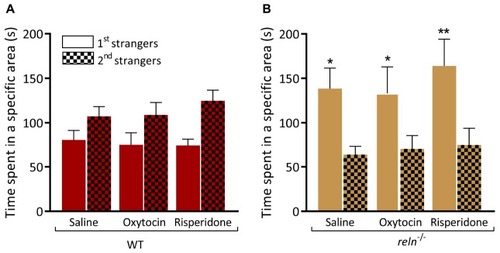
Oxytocin and risperidone do not rescue preference for social novelty. (A) WT treated with saline (p = 0.57), oxytocin (p = 0.53), and risperidone (p = 0.14) spend equal time near the two groups of unfamiliar fish. (B) Neither oxytocin (p = 0.048) nor risperidone (p = 0.0023) treatment rescues the impaired preference for social novelty of reln–/– zebrafish (saline control, p = 0.014). Three-way ANOVA followed by Sidak’s post hoc for oxytocin, genotype factor: F(1,64) = 0.3928, p = 0.53, stranger factor: F(1,64) = 2.133, p = 0.15, treatment factor: F(1,64) = 0.0143, p = 0.90, interaction genotype × stranger: F(1,64) = 17.44, p < 0.0001, interaction genotype × treatment: F(1,64) = 0.0282, p = 0.87, interaction stranger × treatment: F(1,64) = 0.0707, p = 0.79, interaction stranger × genotype × treatment: F(1,64) = 0.04759, p = 0.83. Three-way ANOVA followed by Sidak’s post hoc for risperidone, genotype factor: F(1,64) = 1.073, p = 0.30, stranger factor: F(1,64) = 2.573, p = 0.11, treatment factor: F(1,64) = 0.8058, p = 0.37, interaction genotype × stranger: F(1,64) = 25.65, p < 0.0001, interaction genotype × treatment: F(1,64) = 0.3363, p = 0.56, interaction stranger × treatment: F(1,64) = 0.01244, p = 0.91, interaction stranger × genotype × treatment: F(1,64) = 0.4869, p = 0.49. n = 9 WT and n = 9 reln–/–. ∗p < 0.05, ∗∗p < 0.01. Mean ± SEM.
|

